Critical Evaluation of Infection Prevention and Control Procedures
VerifiedAdded on 2022/11/30
|11
|3777
|444
Report
AI Summary
This report presents a critical evaluation of infection prevention and control practices within healthcare settings, specifically focusing on Australian hospitals. It begins with an introduction highlighting the importance of established procedures and policies in ensuring patient and employee safety, particularly in the context of the COVID-19 pandemic. The background and context section discusses the spread of infections, using a case study of a home care facility to illustrate the impact of outbreaks and the need for improved strategies. The report emphasizes the significance of updated policies, adherence to guidelines, and the implementation of a dedicated, well-trained infection prevention and control team. It also covers the need for regular monitoring, evaluation, and the provision of resources to healthcare settings. The strategy section proposes several key strategies for improving infection control, including regular policy updates, adherence to guidelines, and the establishment of surveillance systems. The report stresses the importance of hand hygiene, environmental sanitation, and sufficient staffing to prevent the spread of infections. The report also discusses the importance of facility design, and the need for training and education programs for medical personnel. The report concludes with a call for continuous improvement and adaptation of infection control measures to address current and future challenges.
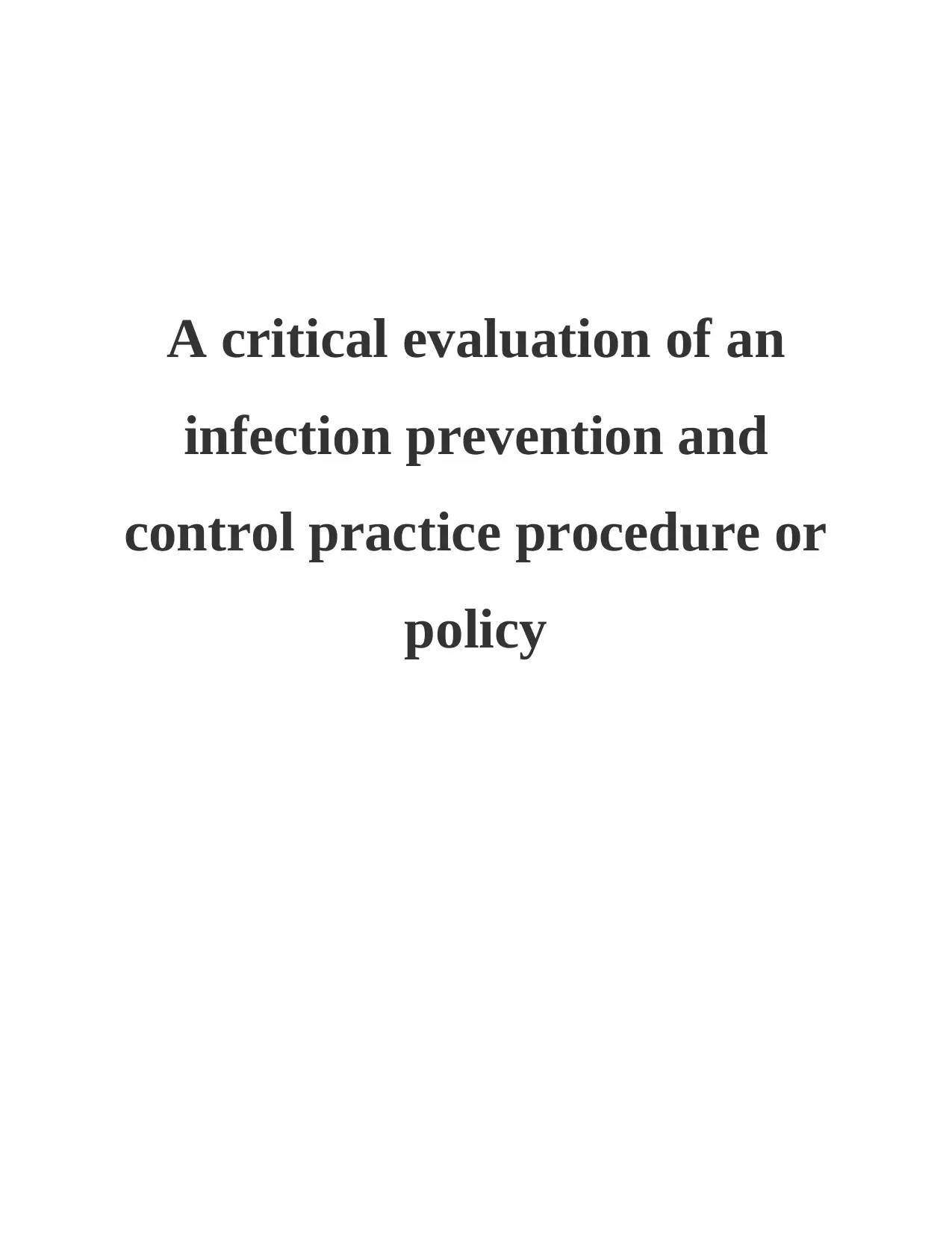
A critical evaluation of an
infection prevention and
control practice procedure or
policy
infection prevention and
control practice procedure or
policy
Paraphrase This Document
Need a fresh take? Get an instant paraphrase of this document with our AI Paraphraser
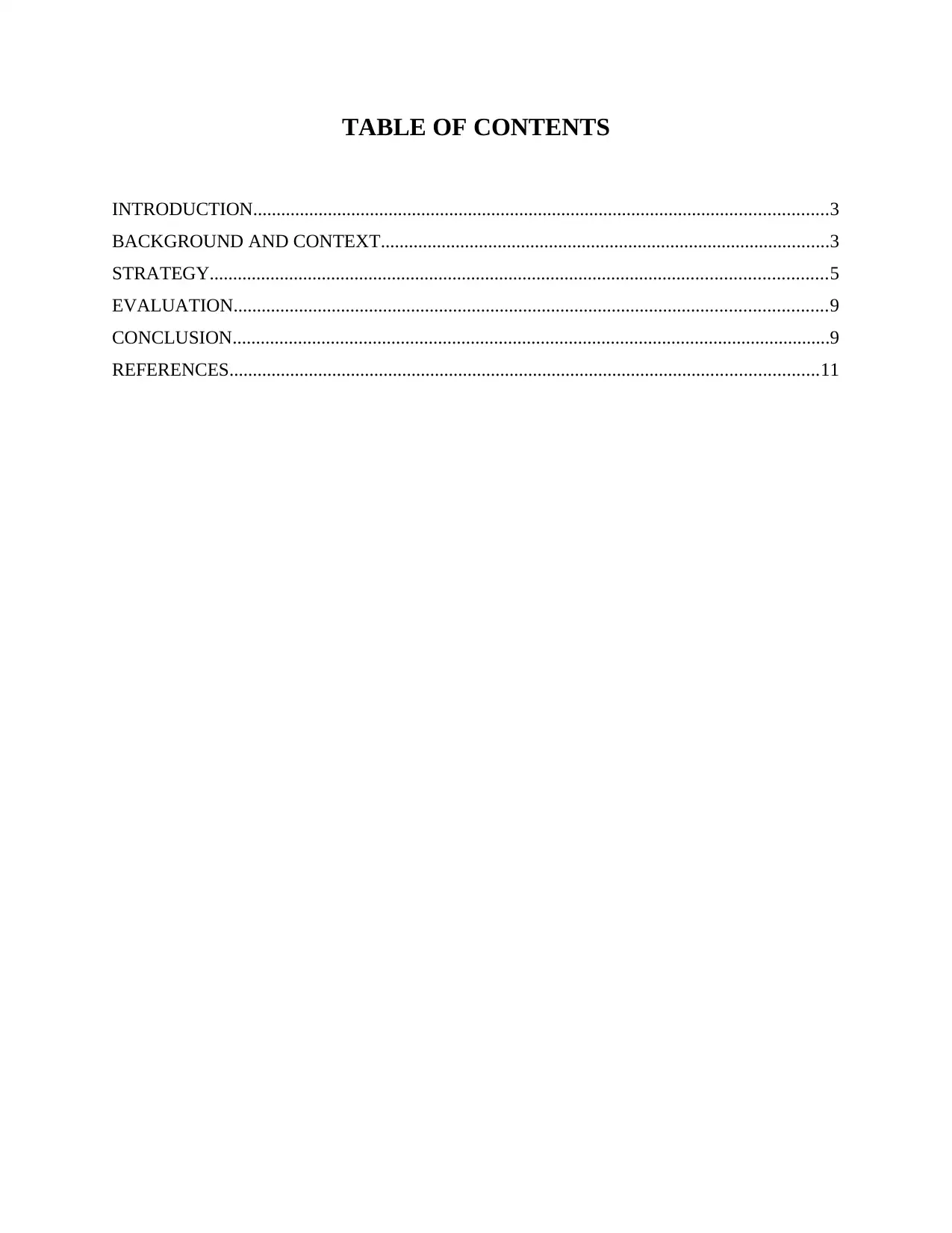
TABLE OF CONTENTS
INTRODUCTION...........................................................................................................................3
BACKGROUND AND CONTEXT................................................................................................3
STRATEGY....................................................................................................................................5
EVALUATION...............................................................................................................................9
CONCLUSION................................................................................................................................9
REFERENCES..............................................................................................................................11
INTRODUCTION...........................................................................................................................3
BACKGROUND AND CONTEXT................................................................................................3
STRATEGY....................................................................................................................................5
EVALUATION...............................................................................................................................9
CONCLUSION................................................................................................................................9
REFERENCES..............................................................................................................................11
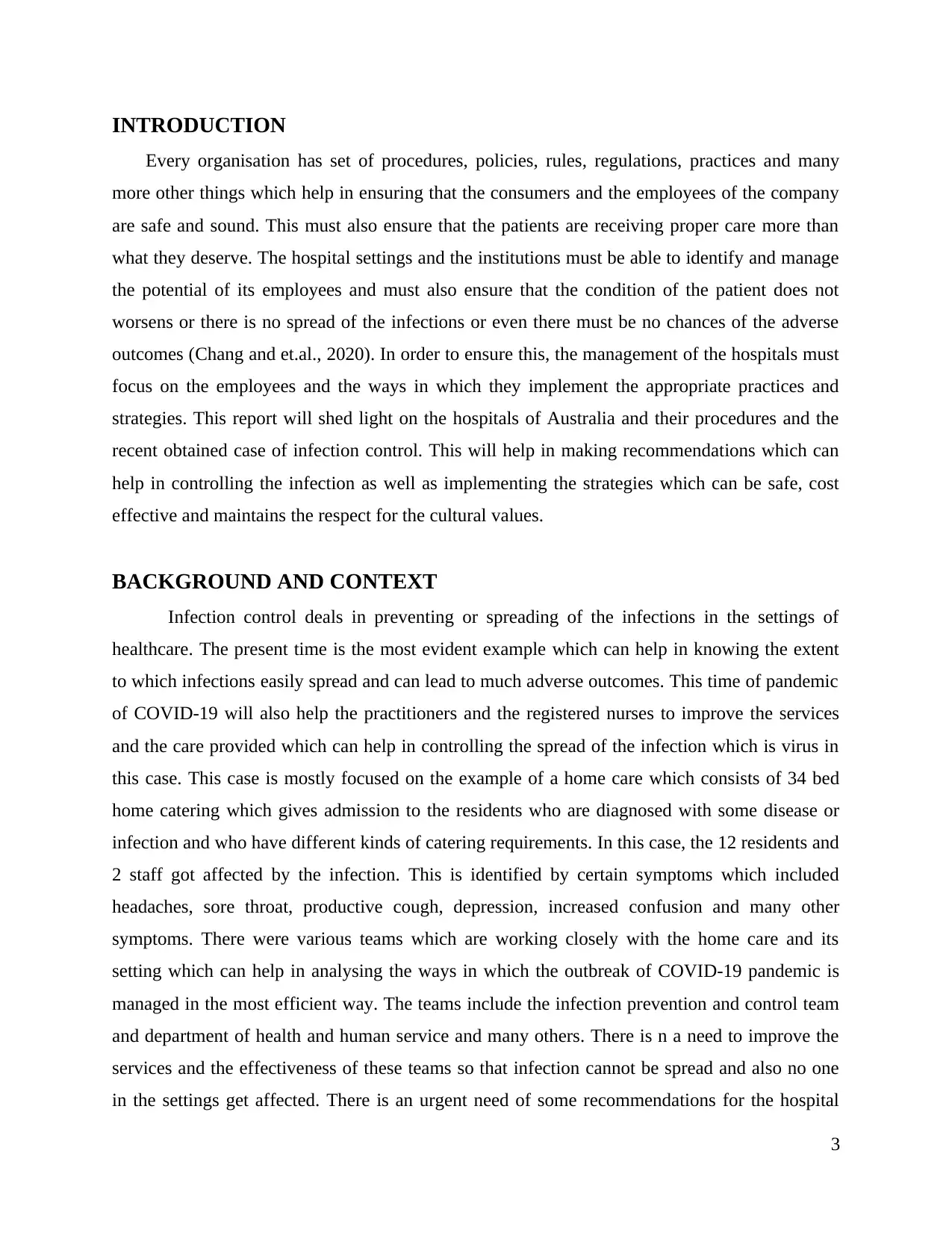
INTRODUCTION
Every organisation has set of procedures, policies, rules, regulations, practices and many
more other things which help in ensuring that the consumers and the employees of the company
are safe and sound. This must also ensure that the patients are receiving proper care more than
what they deserve. The hospital settings and the institutions must be able to identify and manage
the potential of its employees and must also ensure that the condition of the patient does not
worsens or there is no spread of the infections or even there must be no chances of the adverse
outcomes (Chang and et.al., 2020). In order to ensure this, the management of the hospitals must
focus on the employees and the ways in which they implement the appropriate practices and
strategies. This report will shed light on the hospitals of Australia and their procedures and the
recent obtained case of infection control. This will help in making recommendations which can
help in controlling the infection as well as implementing the strategies which can be safe, cost
effective and maintains the respect for the cultural values.
BACKGROUND AND CONTEXT
Infection control deals in preventing or spreading of the infections in the settings of
healthcare. The present time is the most evident example which can help in knowing the extent
to which infections easily spread and can lead to much adverse outcomes. This time of pandemic
of COVID-19 will also help the practitioners and the registered nurses to improve the services
and the care provided which can help in controlling the spread of the infection which is virus in
this case. This case is mostly focused on the example of a home care which consists of 34 bed
home catering which gives admission to the residents who are diagnosed with some disease or
infection and who have different kinds of catering requirements. In this case, the 12 residents and
2 staff got affected by the infection. This is identified by certain symptoms which included
headaches, sore throat, productive cough, depression, increased confusion and many other
symptoms. There were various teams which are working closely with the home care and its
setting which can help in analysing the ways in which the outbreak of COVID-19 pandemic is
managed in the most efficient way. The teams include the infection prevention and control team
and department of health and human service and many others. There is n a need to improve the
services and the effectiveness of these teams so that infection cannot be spread and also no one
in the settings get affected. There is an urgent need of some recommendations for the hospital
3
Every organisation has set of procedures, policies, rules, regulations, practices and many
more other things which help in ensuring that the consumers and the employees of the company
are safe and sound. This must also ensure that the patients are receiving proper care more than
what they deserve. The hospital settings and the institutions must be able to identify and manage
the potential of its employees and must also ensure that the condition of the patient does not
worsens or there is no spread of the infections or even there must be no chances of the adverse
outcomes (Chang and et.al., 2020). In order to ensure this, the management of the hospitals must
focus on the employees and the ways in which they implement the appropriate practices and
strategies. This report will shed light on the hospitals of Australia and their procedures and the
recent obtained case of infection control. This will help in making recommendations which can
help in controlling the infection as well as implementing the strategies which can be safe, cost
effective and maintains the respect for the cultural values.
BACKGROUND AND CONTEXT
Infection control deals in preventing or spreading of the infections in the settings of
healthcare. The present time is the most evident example which can help in knowing the extent
to which infections easily spread and can lead to much adverse outcomes. This time of pandemic
of COVID-19 will also help the practitioners and the registered nurses to improve the services
and the care provided which can help in controlling the spread of the infection which is virus in
this case. This case is mostly focused on the example of a home care which consists of 34 bed
home catering which gives admission to the residents who are diagnosed with some disease or
infection and who have different kinds of catering requirements. In this case, the 12 residents and
2 staff got affected by the infection. This is identified by certain symptoms which included
headaches, sore throat, productive cough, depression, increased confusion and many other
symptoms. There were various teams which are working closely with the home care and its
setting which can help in analysing the ways in which the outbreak of COVID-19 pandemic is
managed in the most efficient way. The teams include the infection prevention and control team
and department of health and human service and many others. There is n a need to improve the
services and the effectiveness of these teams so that infection cannot be spread and also no one
in the settings get affected. There is an urgent need of some recommendations for the hospital
3
⊘ This is a preview!⊘
Do you want full access?
Subscribe today to unlock all pages.

Trusted by 1+ million students worldwide
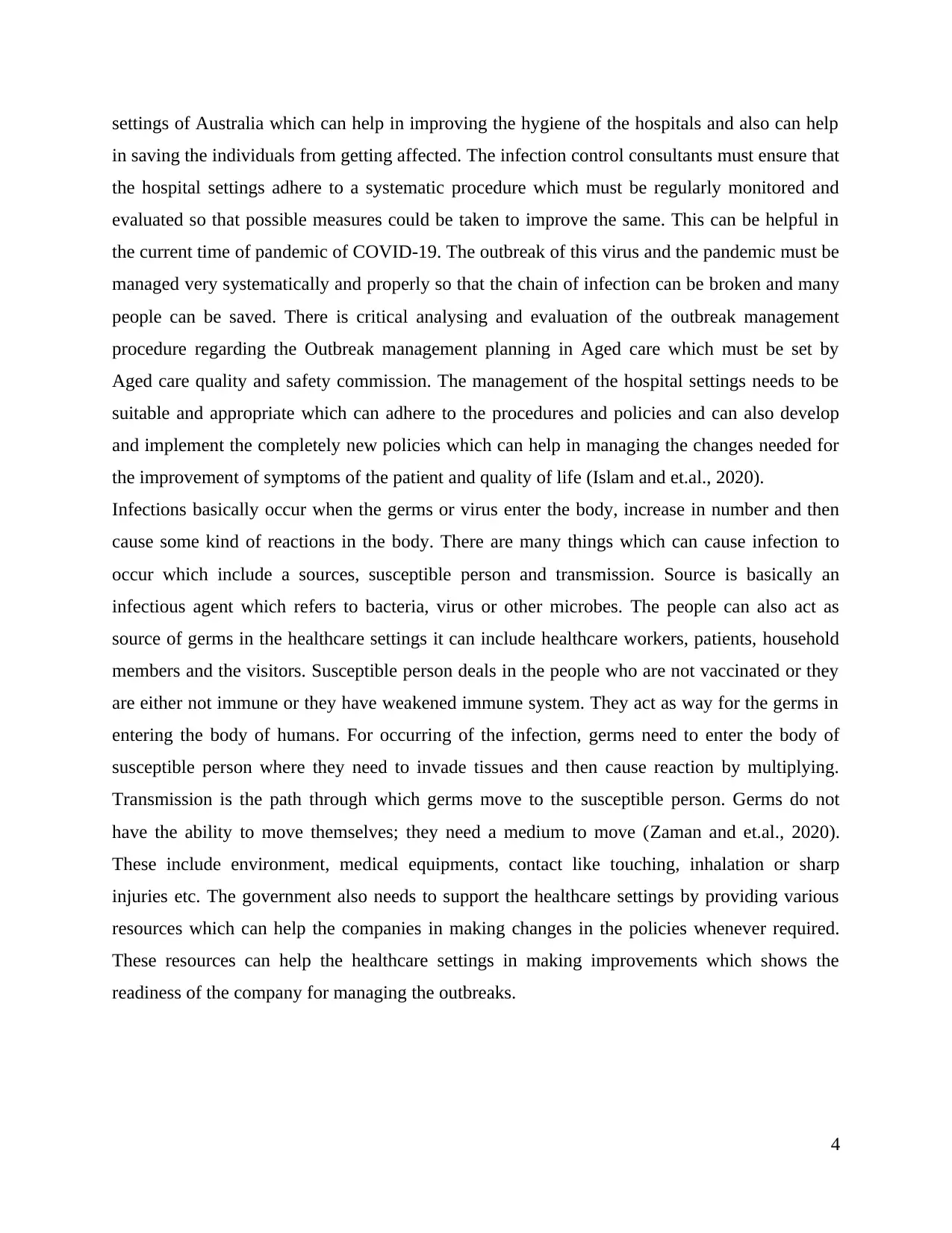
settings of Australia which can help in improving the hygiene of the hospitals and also can help
in saving the individuals from getting affected. The infection control consultants must ensure that
the hospital settings adhere to a systematic procedure which must be regularly monitored and
evaluated so that possible measures could be taken to improve the same. This can be helpful in
the current time of pandemic of COVID-19. The outbreak of this virus and the pandemic must be
managed very systematically and properly so that the chain of infection can be broken and many
people can be saved. There is critical analysing and evaluation of the outbreak management
procedure regarding the Outbreak management planning in Aged care which must be set by
Aged care quality and safety commission. The management of the hospital settings needs to be
suitable and appropriate which can adhere to the procedures and policies and can also develop
and implement the completely new policies which can help in managing the changes needed for
the improvement of symptoms of the patient and quality of life (Islam and et.al., 2020).
Infections basically occur when the germs or virus enter the body, increase in number and then
cause some kind of reactions in the body. There are many things which can cause infection to
occur which include a sources, susceptible person and transmission. Source is basically an
infectious agent which refers to bacteria, virus or other microbes. The people can also act as
source of germs in the healthcare settings it can include healthcare workers, patients, household
members and the visitors. Susceptible person deals in the people who are not vaccinated or they
are either not immune or they have weakened immune system. They act as way for the germs in
entering the body of humans. For occurring of the infection, germs need to enter the body of
susceptible person where they need to invade tissues and then cause reaction by multiplying.
Transmission is the path through which germs move to the susceptible person. Germs do not
have the ability to move themselves; they need a medium to move (Zaman and et.al., 2020).
These include environment, medical equipments, contact like touching, inhalation or sharp
injuries etc. The government also needs to support the healthcare settings by providing various
resources which can help the companies in making changes in the policies whenever required.
These resources can help the healthcare settings in making improvements which shows the
readiness of the company for managing the outbreaks.
4
in saving the individuals from getting affected. The infection control consultants must ensure that
the hospital settings adhere to a systematic procedure which must be regularly monitored and
evaluated so that possible measures could be taken to improve the same. This can be helpful in
the current time of pandemic of COVID-19. The outbreak of this virus and the pandemic must be
managed very systematically and properly so that the chain of infection can be broken and many
people can be saved. There is critical analysing and evaluation of the outbreak management
procedure regarding the Outbreak management planning in Aged care which must be set by
Aged care quality and safety commission. The management of the hospital settings needs to be
suitable and appropriate which can adhere to the procedures and policies and can also develop
and implement the completely new policies which can help in managing the changes needed for
the improvement of symptoms of the patient and quality of life (Islam and et.al., 2020).
Infections basically occur when the germs or virus enter the body, increase in number and then
cause some kind of reactions in the body. There are many things which can cause infection to
occur which include a sources, susceptible person and transmission. Source is basically an
infectious agent which refers to bacteria, virus or other microbes. The people can also act as
source of germs in the healthcare settings it can include healthcare workers, patients, household
members and the visitors. Susceptible person deals in the people who are not vaccinated or they
are either not immune or they have weakened immune system. They act as way for the germs in
entering the body of humans. For occurring of the infection, germs need to enter the body of
susceptible person where they need to invade tissues and then cause reaction by multiplying.
Transmission is the path through which germs move to the susceptible person. Germs do not
have the ability to move themselves; they need a medium to move (Zaman and et.al., 2020).
These include environment, medical equipments, contact like touching, inhalation or sharp
injuries etc. The government also needs to support the healthcare settings by providing various
resources which can help the companies in making changes in the policies whenever required.
These resources can help the healthcare settings in making improvements which shows the
readiness of the company for managing the outbreaks.
4
Paraphrase This Document
Need a fresh take? Get an instant paraphrase of this document with our AI Paraphraser
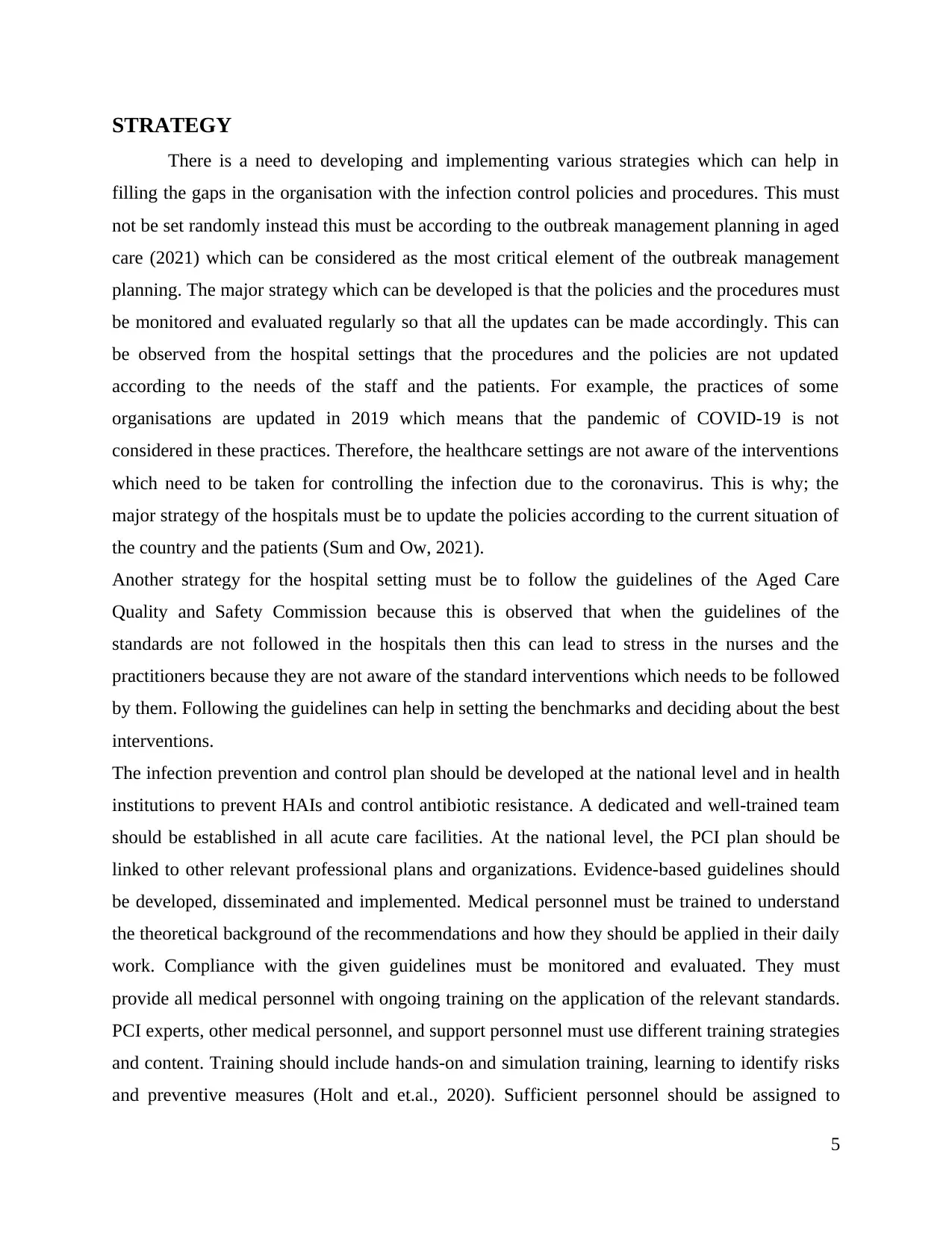
STRATEGY
There is a need to developing and implementing various strategies which can help in
filling the gaps in the organisation with the infection control policies and procedures. This must
not be set randomly instead this must be according to the outbreak management planning in aged
care (2021) which can be considered as the most critical element of the outbreak management
planning. The major strategy which can be developed is that the policies and the procedures must
be monitored and evaluated regularly so that all the updates can be made accordingly. This can
be observed from the hospital settings that the procedures and the policies are not updated
according to the needs of the staff and the patients. For example, the practices of some
organisations are updated in 2019 which means that the pandemic of COVID-19 is not
considered in these practices. Therefore, the healthcare settings are not aware of the interventions
which need to be taken for controlling the infection due to the coronavirus. This is why; the
major strategy of the hospitals must be to update the policies according to the current situation of
the country and the patients (Sum and Ow, 2021).
Another strategy for the hospital setting must be to follow the guidelines of the Aged Care
Quality and Safety Commission because this is observed that when the guidelines of the
standards are not followed in the hospitals then this can lead to stress in the nurses and the
practitioners because they are not aware of the standard interventions which needs to be followed
by them. Following the guidelines can help in setting the benchmarks and deciding about the best
interventions.
The infection prevention and control plan should be developed at the national level and in health
institutions to prevent HAIs and control antibiotic resistance. A dedicated and well-trained team
should be established in all acute care facilities. At the national level, the PCI plan should be
linked to other relevant professional plans and organizations. Evidence-based guidelines should
be developed, disseminated and implemented. Medical personnel must be trained to understand
the theoretical background of the recommendations and how they should be applied in their daily
work. Compliance with the given guidelines must be monitored and evaluated. They must
provide all medical personnel with ongoing training on the application of the relevant standards.
PCI experts, other medical personnel, and support personnel must use different training strategies
and content. Training should include hands-on and simulation training, learning to identify risks
and preventive measures (Holt and et.al., 2020). Sufficient personnel should be assigned to
5
There is a need to developing and implementing various strategies which can help in
filling the gaps in the organisation with the infection control policies and procedures. This must
not be set randomly instead this must be according to the outbreak management planning in aged
care (2021) which can be considered as the most critical element of the outbreak management
planning. The major strategy which can be developed is that the policies and the procedures must
be monitored and evaluated regularly so that all the updates can be made accordingly. This can
be observed from the hospital settings that the procedures and the policies are not updated
according to the needs of the staff and the patients. For example, the practices of some
organisations are updated in 2019 which means that the pandemic of COVID-19 is not
considered in these practices. Therefore, the healthcare settings are not aware of the interventions
which need to be taken for controlling the infection due to the coronavirus. This is why; the
major strategy of the hospitals must be to update the policies according to the current situation of
the country and the patients (Sum and Ow, 2021).
Another strategy for the hospital setting must be to follow the guidelines of the Aged Care
Quality and Safety Commission because this is observed that when the guidelines of the
standards are not followed in the hospitals then this can lead to stress in the nurses and the
practitioners because they are not aware of the standard interventions which needs to be followed
by them. Following the guidelines can help in setting the benchmarks and deciding about the best
interventions.
The infection prevention and control plan should be developed at the national level and in health
institutions to prevent HAIs and control antibiotic resistance. A dedicated and well-trained team
should be established in all acute care facilities. At the national level, the PCI plan should be
linked to other relevant professional plans and organizations. Evidence-based guidelines should
be developed, disseminated and implemented. Medical personnel must be trained to understand
the theoretical background of the recommendations and how they should be applied in their daily
work. Compliance with the given guidelines must be monitored and evaluated. They must
provide all medical personnel with ongoing training on the application of the relevant standards.
PCI experts, other medical personnel, and support personnel must use different training strategies
and content. Training should include hands-on and simulation training, learning to identify risks
and preventive measures (Holt and et.al., 2020). Sufficient personnel should be assigned to
5
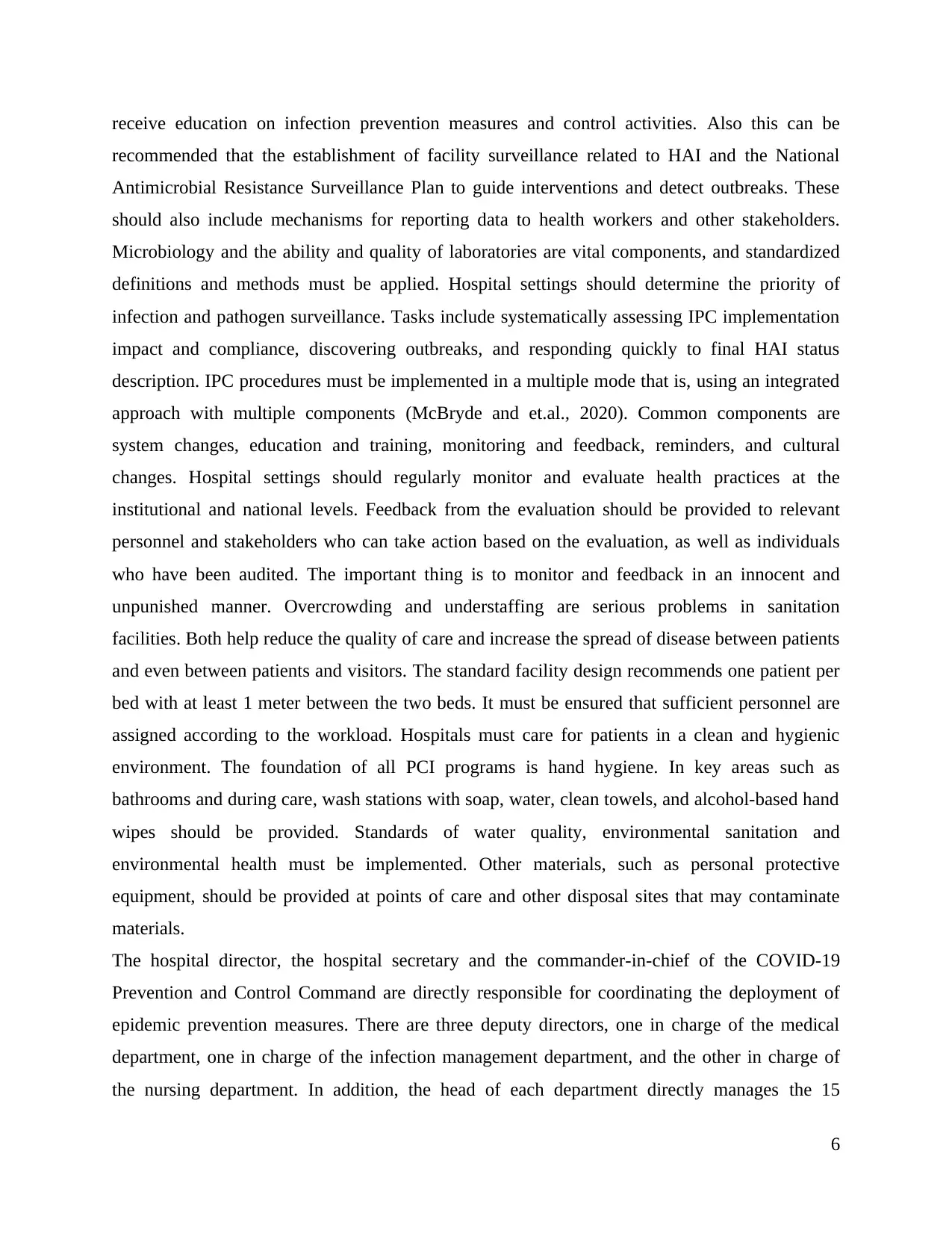
receive education on infection prevention measures and control activities. Also this can be
recommended that the establishment of facility surveillance related to HAI and the National
Antimicrobial Resistance Surveillance Plan to guide interventions and detect outbreaks. These
should also include mechanisms for reporting data to health workers and other stakeholders.
Microbiology and the ability and quality of laboratories are vital components, and standardized
definitions and methods must be applied. Hospital settings should determine the priority of
infection and pathogen surveillance. Tasks include systematically assessing IPC implementation
impact and compliance, discovering outbreaks, and responding quickly to final HAI status
description. IPC procedures must be implemented in a multiple mode that is, using an integrated
approach with multiple components (McBryde and et.al., 2020). Common components are
system changes, education and training, monitoring and feedback, reminders, and cultural
changes. Hospital settings should regularly monitor and evaluate health practices at the
institutional and national levels. Feedback from the evaluation should be provided to relevant
personnel and stakeholders who can take action based on the evaluation, as well as individuals
who have been audited. The important thing is to monitor and feedback in an innocent and
unpunished manner. Overcrowding and understaffing are serious problems in sanitation
facilities. Both help reduce the quality of care and increase the spread of disease between patients
and even between patients and visitors. The standard facility design recommends one patient per
bed with at least 1 meter between the two beds. It must be ensured that sufficient personnel are
assigned according to the workload. Hospitals must care for patients in a clean and hygienic
environment. The foundation of all PCI programs is hand hygiene. In key areas such as
bathrooms and during care, wash stations with soap, water, clean towels, and alcohol-based hand
wipes should be provided. Standards of water quality, environmental sanitation and
environmental health must be implemented. Other materials, such as personal protective
equipment, should be provided at points of care and other disposal sites that may contaminate
materials.
The hospital director, the hospital secretary and the commander-in-chief of the COVID-19
Prevention and Control Command are directly responsible for coordinating the deployment of
epidemic prevention measures. There are three deputy directors, one in charge of the medical
department, one in charge of the infection management department, and the other in charge of
the nursing department. In addition, the head of each department directly manages the 15
6
recommended that the establishment of facility surveillance related to HAI and the National
Antimicrobial Resistance Surveillance Plan to guide interventions and detect outbreaks. These
should also include mechanisms for reporting data to health workers and other stakeholders.
Microbiology and the ability and quality of laboratories are vital components, and standardized
definitions and methods must be applied. Hospital settings should determine the priority of
infection and pathogen surveillance. Tasks include systematically assessing IPC implementation
impact and compliance, discovering outbreaks, and responding quickly to final HAI status
description. IPC procedures must be implemented in a multiple mode that is, using an integrated
approach with multiple components (McBryde and et.al., 2020). Common components are
system changes, education and training, monitoring and feedback, reminders, and cultural
changes. Hospital settings should regularly monitor and evaluate health practices at the
institutional and national levels. Feedback from the evaluation should be provided to relevant
personnel and stakeholders who can take action based on the evaluation, as well as individuals
who have been audited. The important thing is to monitor and feedback in an innocent and
unpunished manner. Overcrowding and understaffing are serious problems in sanitation
facilities. Both help reduce the quality of care and increase the spread of disease between patients
and even between patients and visitors. The standard facility design recommends one patient per
bed with at least 1 meter between the two beds. It must be ensured that sufficient personnel are
assigned according to the workload. Hospitals must care for patients in a clean and hygienic
environment. The foundation of all PCI programs is hand hygiene. In key areas such as
bathrooms and during care, wash stations with soap, water, clean towels, and alcohol-based hand
wipes should be provided. Standards of water quality, environmental sanitation and
environmental health must be implemented. Other materials, such as personal protective
equipment, should be provided at points of care and other disposal sites that may contaminate
materials.
The hospital director, the hospital secretary and the commander-in-chief of the COVID-19
Prevention and Control Command are directly responsible for coordinating the deployment of
epidemic prevention measures. There are three deputy directors, one in charge of the medical
department, one in charge of the infection management department, and the other in charge of
the nursing department. In addition, the head of each department directly manages the 15
6
⊘ This is a preview!⊘
Do you want full access?
Subscribe today to unlock all pages.

Trusted by 1+ million students worldwide
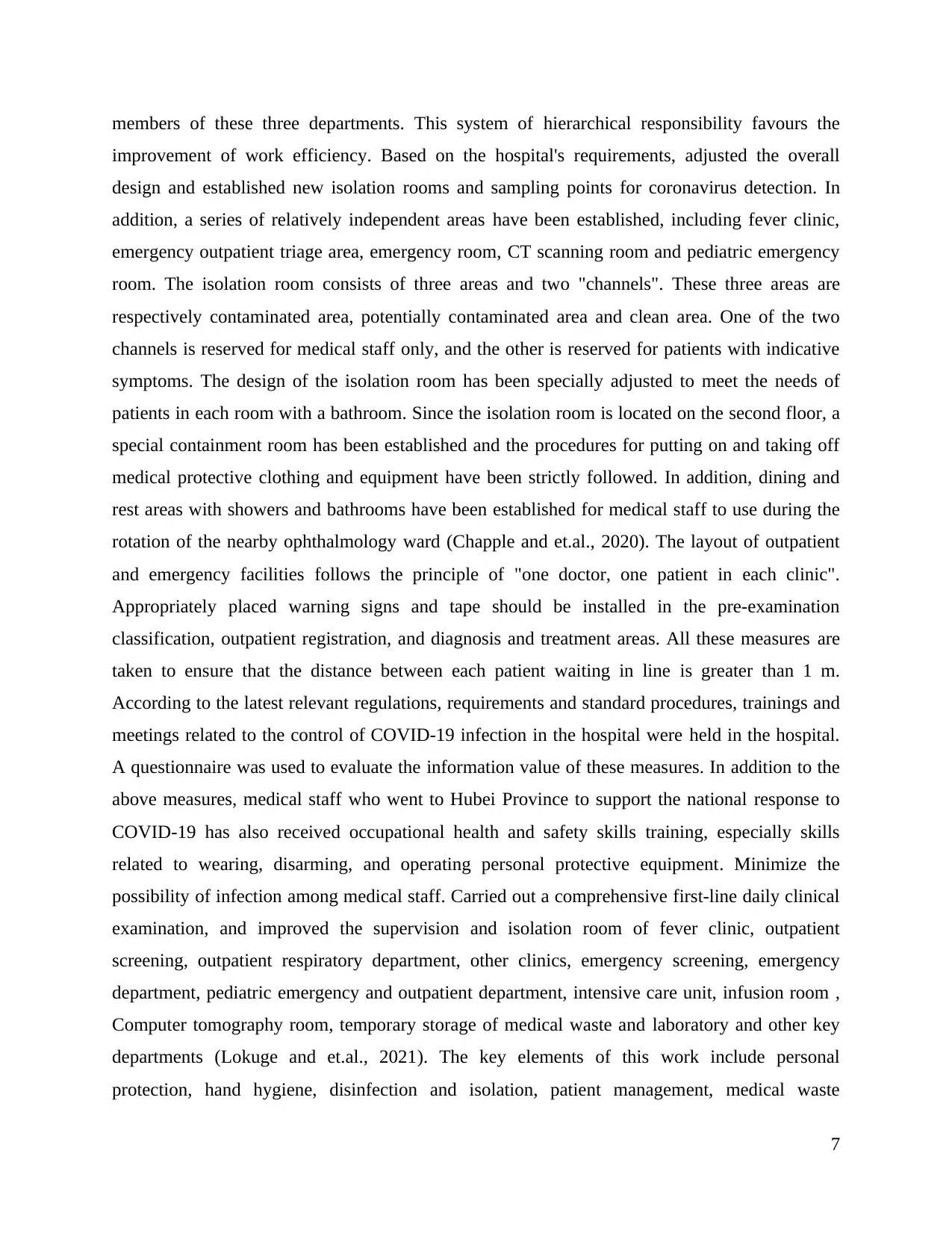
members of these three departments. This system of hierarchical responsibility favours the
improvement of work efficiency. Based on the hospital's requirements, adjusted the overall
design and established new isolation rooms and sampling points for coronavirus detection. In
addition, a series of relatively independent areas have been established, including fever clinic,
emergency outpatient triage area, emergency room, CT scanning room and pediatric emergency
room. The isolation room consists of three areas and two "channels". These three areas are
respectively contaminated area, potentially contaminated area and clean area. One of the two
channels is reserved for medical staff only, and the other is reserved for patients with indicative
symptoms. The design of the isolation room has been specially adjusted to meet the needs of
patients in each room with a bathroom. Since the isolation room is located on the second floor, a
special containment room has been established and the procedures for putting on and taking off
medical protective clothing and equipment have been strictly followed. In addition, dining and
rest areas with showers and bathrooms have been established for medical staff to use during the
rotation of the nearby ophthalmology ward (Chapple and et.al., 2020). The layout of outpatient
and emergency facilities follows the principle of "one doctor, one patient in each clinic".
Appropriately placed warning signs and tape should be installed in the pre-examination
classification, outpatient registration, and diagnosis and treatment areas. All these measures are
taken to ensure that the distance between each patient waiting in line is greater than 1 m.
According to the latest relevant regulations, requirements and standard procedures, trainings and
meetings related to the control of COVID-19 infection in the hospital were held in the hospital.
A questionnaire was used to evaluate the information value of these measures. In addition to the
above measures, medical staff who went to Hubei Province to support the national response to
COVID-19 has also received occupational health and safety skills training, especially skills
related to wearing, disarming, and operating personal protective equipment. Minimize the
possibility of infection among medical staff. Carried out a comprehensive first-line daily clinical
examination, and improved the supervision and isolation room of fever clinic, outpatient
screening, outpatient respiratory department, other clinics, emergency screening, emergency
department, pediatric emergency and outpatient department, intensive care unit, infusion room ,
Computer tomography room, temporary storage of medical waste and laboratory and other key
departments (Lokuge and et.al., 2021). The key elements of this work include personal
protection, hand hygiene, disinfection and isolation, patient management, medical waste
7
improvement of work efficiency. Based on the hospital's requirements, adjusted the overall
design and established new isolation rooms and sampling points for coronavirus detection. In
addition, a series of relatively independent areas have been established, including fever clinic,
emergency outpatient triage area, emergency room, CT scanning room and pediatric emergency
room. The isolation room consists of three areas and two "channels". These three areas are
respectively contaminated area, potentially contaminated area and clean area. One of the two
channels is reserved for medical staff only, and the other is reserved for patients with indicative
symptoms. The design of the isolation room has been specially adjusted to meet the needs of
patients in each room with a bathroom. Since the isolation room is located on the second floor, a
special containment room has been established and the procedures for putting on and taking off
medical protective clothing and equipment have been strictly followed. In addition, dining and
rest areas with showers and bathrooms have been established for medical staff to use during the
rotation of the nearby ophthalmology ward (Chapple and et.al., 2020). The layout of outpatient
and emergency facilities follows the principle of "one doctor, one patient in each clinic".
Appropriately placed warning signs and tape should be installed in the pre-examination
classification, outpatient registration, and diagnosis and treatment areas. All these measures are
taken to ensure that the distance between each patient waiting in line is greater than 1 m.
According to the latest relevant regulations, requirements and standard procedures, trainings and
meetings related to the control of COVID-19 infection in the hospital were held in the hospital.
A questionnaire was used to evaluate the information value of these measures. In addition to the
above measures, medical staff who went to Hubei Province to support the national response to
COVID-19 has also received occupational health and safety skills training, especially skills
related to wearing, disarming, and operating personal protective equipment. Minimize the
possibility of infection among medical staff. Carried out a comprehensive first-line daily clinical
examination, and improved the supervision and isolation room of fever clinic, outpatient
screening, outpatient respiratory department, other clinics, emergency screening, emergency
department, pediatric emergency and outpatient department, intensive care unit, infusion room ,
Computer tomography room, temporary storage of medical waste and laboratory and other key
departments (Lokuge and et.al., 2021). The key elements of this work include personal
protection, hand hygiene, disinfection and isolation, patient management, medical waste
7
Paraphrase This Document
Need a fresh take? Get an instant paraphrase of this document with our AI Paraphraser
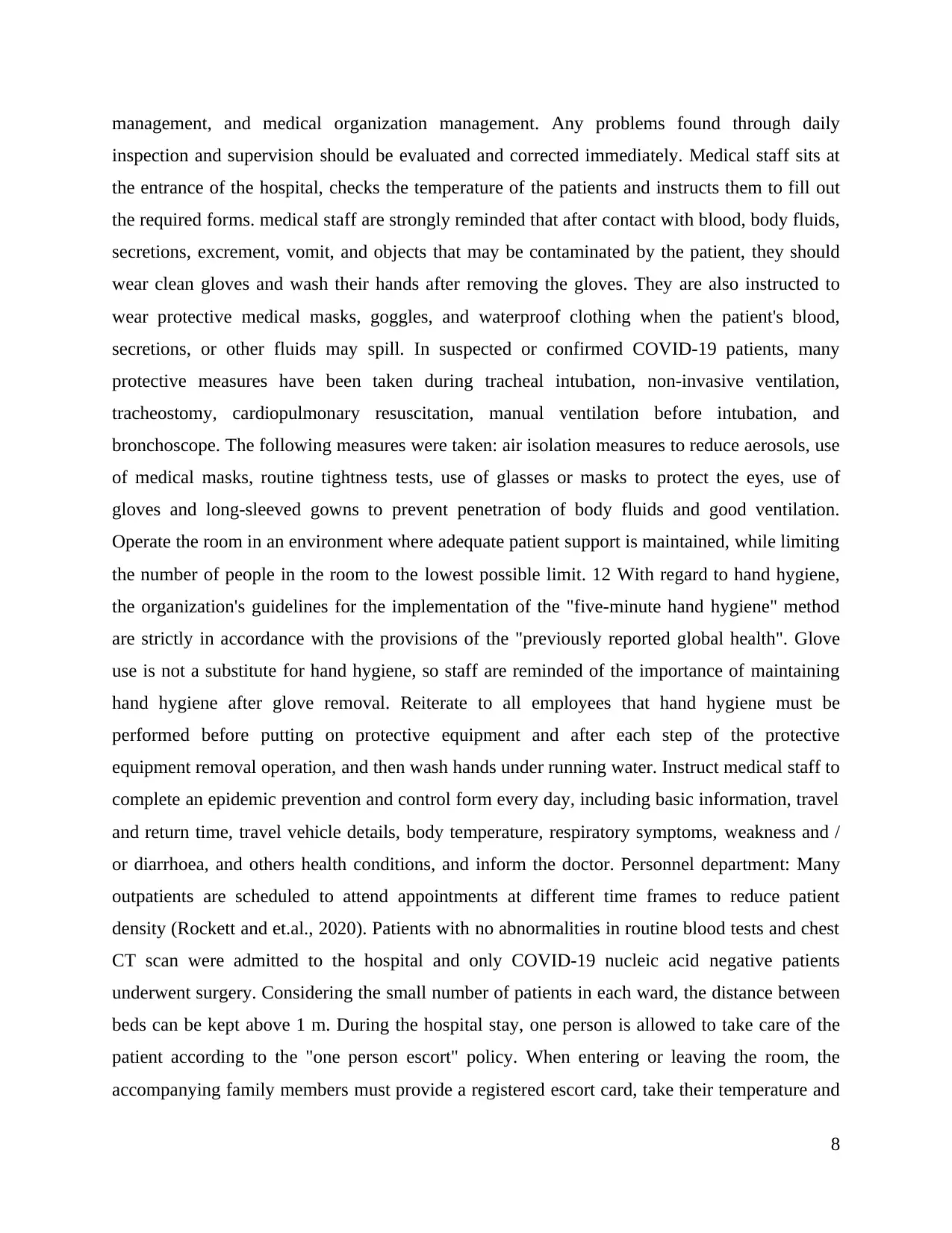
management, and medical organization management. Any problems found through daily
inspection and supervision should be evaluated and corrected immediately. Medical staff sits at
the entrance of the hospital, checks the temperature of the patients and instructs them to fill out
the required forms. medical staff are strongly reminded that after contact with blood, body fluids,
secretions, excrement, vomit, and objects that may be contaminated by the patient, they should
wear clean gloves and wash their hands after removing the gloves. They are also instructed to
wear protective medical masks, goggles, and waterproof clothing when the patient's blood,
secretions, or other fluids may spill. In suspected or confirmed COVID-19 patients, many
protective measures have been taken during tracheal intubation, non-invasive ventilation,
tracheostomy, cardiopulmonary resuscitation, manual ventilation before intubation, and
bronchoscope. The following measures were taken: air isolation measures to reduce aerosols, use
of medical masks, routine tightness tests, use of glasses or masks to protect the eyes, use of
gloves and long-sleeved gowns to prevent penetration of body fluids and good ventilation.
Operate the room in an environment where adequate patient support is maintained, while limiting
the number of people in the room to the lowest possible limit. 12 With regard to hand hygiene,
the organization's guidelines for the implementation of the "five-minute hand hygiene" method
are strictly in accordance with the provisions of the "previously reported global health". Glove
use is not a substitute for hand hygiene, so staff are reminded of the importance of maintaining
hand hygiene after glove removal. Reiterate to all employees that hand hygiene must be
performed before putting on protective equipment and after each step of the protective
equipment removal operation, and then wash hands under running water. Instruct medical staff to
complete an epidemic prevention and control form every day, including basic information, travel
and return time, travel vehicle details, body temperature, respiratory symptoms, weakness and /
or diarrhoea, and others health conditions, and inform the doctor. Personnel department: Many
outpatients are scheduled to attend appointments at different time frames to reduce patient
density (Rockett and et.al., 2020). Patients with no abnormalities in routine blood tests and chest
CT scan were admitted to the hospital and only COVID-19 nucleic acid negative patients
underwent surgery. Considering the small number of patients in each ward, the distance between
beds can be kept above 1 m. During the hospital stay, one person is allowed to take care of the
patient according to the "one person escort" policy. When entering or leaving the room, the
accompanying family members must provide a registered escort card, take their temperature and
8
inspection and supervision should be evaluated and corrected immediately. Medical staff sits at
the entrance of the hospital, checks the temperature of the patients and instructs them to fill out
the required forms. medical staff are strongly reminded that after contact with blood, body fluids,
secretions, excrement, vomit, and objects that may be contaminated by the patient, they should
wear clean gloves and wash their hands after removing the gloves. They are also instructed to
wear protective medical masks, goggles, and waterproof clothing when the patient's blood,
secretions, or other fluids may spill. In suspected or confirmed COVID-19 patients, many
protective measures have been taken during tracheal intubation, non-invasive ventilation,
tracheostomy, cardiopulmonary resuscitation, manual ventilation before intubation, and
bronchoscope. The following measures were taken: air isolation measures to reduce aerosols, use
of medical masks, routine tightness tests, use of glasses or masks to protect the eyes, use of
gloves and long-sleeved gowns to prevent penetration of body fluids and good ventilation.
Operate the room in an environment where adequate patient support is maintained, while limiting
the number of people in the room to the lowest possible limit. 12 With regard to hand hygiene,
the organization's guidelines for the implementation of the "five-minute hand hygiene" method
are strictly in accordance with the provisions of the "previously reported global health". Glove
use is not a substitute for hand hygiene, so staff are reminded of the importance of maintaining
hand hygiene after glove removal. Reiterate to all employees that hand hygiene must be
performed before putting on protective equipment and after each step of the protective
equipment removal operation, and then wash hands under running water. Instruct medical staff to
complete an epidemic prevention and control form every day, including basic information, travel
and return time, travel vehicle details, body temperature, respiratory symptoms, weakness and /
or diarrhoea, and others health conditions, and inform the doctor. Personnel department: Many
outpatients are scheduled to attend appointments at different time frames to reduce patient
density (Rockett and et.al., 2020). Patients with no abnormalities in routine blood tests and chest
CT scan were admitted to the hospital and only COVID-19 nucleic acid negative patients
underwent surgery. Considering the small number of patients in each ward, the distance between
beds can be kept above 1 m. During the hospital stay, one person is allowed to take care of the
patient according to the "one person escort" policy. When entering or leaving the room, the
accompanying family members must provide a registered escort card, take their temperature and
8
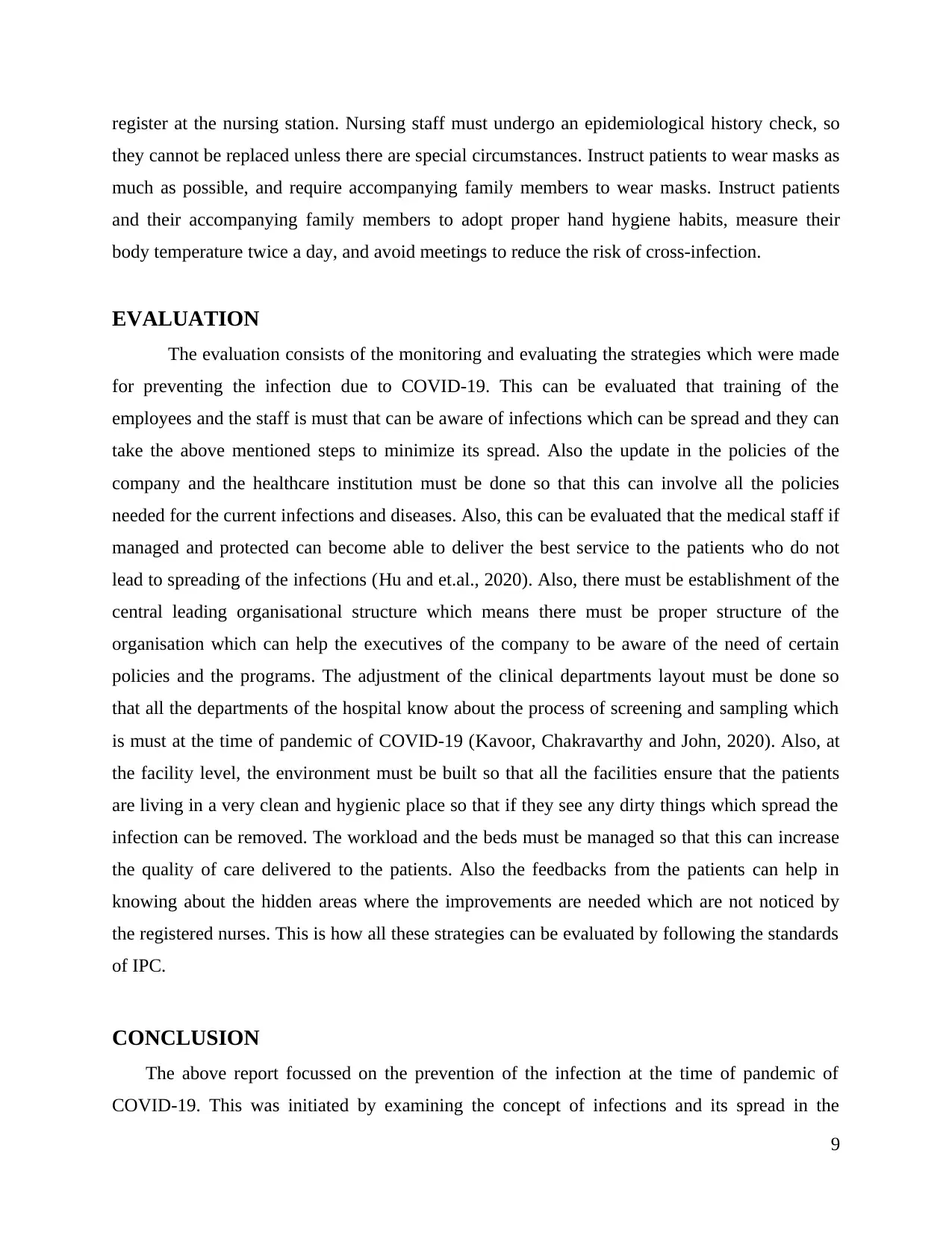
register at the nursing station. Nursing staff must undergo an epidemiological history check, so
they cannot be replaced unless there are special circumstances. Instruct patients to wear masks as
much as possible, and require accompanying family members to wear masks. Instruct patients
and their accompanying family members to adopt proper hand hygiene habits, measure their
body temperature twice a day, and avoid meetings to reduce the risk of cross-infection.
EVALUATION
The evaluation consists of the monitoring and evaluating the strategies which were made
for preventing the infection due to COVID-19. This can be evaluated that training of the
employees and the staff is must that can be aware of infections which can be spread and they can
take the above mentioned steps to minimize its spread. Also the update in the policies of the
company and the healthcare institution must be done so that this can involve all the policies
needed for the current infections and diseases. Also, this can be evaluated that the medical staff if
managed and protected can become able to deliver the best service to the patients who do not
lead to spreading of the infections (Hu and et.al., 2020). Also, there must be establishment of the
central leading organisational structure which means there must be proper structure of the
organisation which can help the executives of the company to be aware of the need of certain
policies and the programs. The adjustment of the clinical departments layout must be done so
that all the departments of the hospital know about the process of screening and sampling which
is must at the time of pandemic of COVID-19 (Kavoor, Chakravarthy and John, 2020). Also, at
the facility level, the environment must be built so that all the facilities ensure that the patients
are living in a very clean and hygienic place so that if they see any dirty things which spread the
infection can be removed. The workload and the beds must be managed so that this can increase
the quality of care delivered to the patients. Also the feedbacks from the patients can help in
knowing about the hidden areas where the improvements are needed which are not noticed by
the registered nurses. This is how all these strategies can be evaluated by following the standards
of IPC.
CONCLUSION
The above report focussed on the prevention of the infection at the time of pandemic of
COVID-19. This was initiated by examining the concept of infections and its spread in the
9
they cannot be replaced unless there are special circumstances. Instruct patients to wear masks as
much as possible, and require accompanying family members to wear masks. Instruct patients
and their accompanying family members to adopt proper hand hygiene habits, measure their
body temperature twice a day, and avoid meetings to reduce the risk of cross-infection.
EVALUATION
The evaluation consists of the monitoring and evaluating the strategies which were made
for preventing the infection due to COVID-19. This can be evaluated that training of the
employees and the staff is must that can be aware of infections which can be spread and they can
take the above mentioned steps to minimize its spread. Also the update in the policies of the
company and the healthcare institution must be done so that this can involve all the policies
needed for the current infections and diseases. Also, this can be evaluated that the medical staff if
managed and protected can become able to deliver the best service to the patients who do not
lead to spreading of the infections (Hu and et.al., 2020). Also, there must be establishment of the
central leading organisational structure which means there must be proper structure of the
organisation which can help the executives of the company to be aware of the need of certain
policies and the programs. The adjustment of the clinical departments layout must be done so
that all the departments of the hospital know about the process of screening and sampling which
is must at the time of pandemic of COVID-19 (Kavoor, Chakravarthy and John, 2020). Also, at
the facility level, the environment must be built so that all the facilities ensure that the patients
are living in a very clean and hygienic place so that if they see any dirty things which spread the
infection can be removed. The workload and the beds must be managed so that this can increase
the quality of care delivered to the patients. Also the feedbacks from the patients can help in
knowing about the hidden areas where the improvements are needed which are not noticed by
the registered nurses. This is how all these strategies can be evaluated by following the standards
of IPC.
CONCLUSION
The above report focussed on the prevention of the infection at the time of pandemic of
COVID-19. This was initiated by examining the concept of infections and its spread in the
9
⊘ This is a preview!⊘
Do you want full access?
Subscribe today to unlock all pages.

Trusted by 1+ million students worldwide
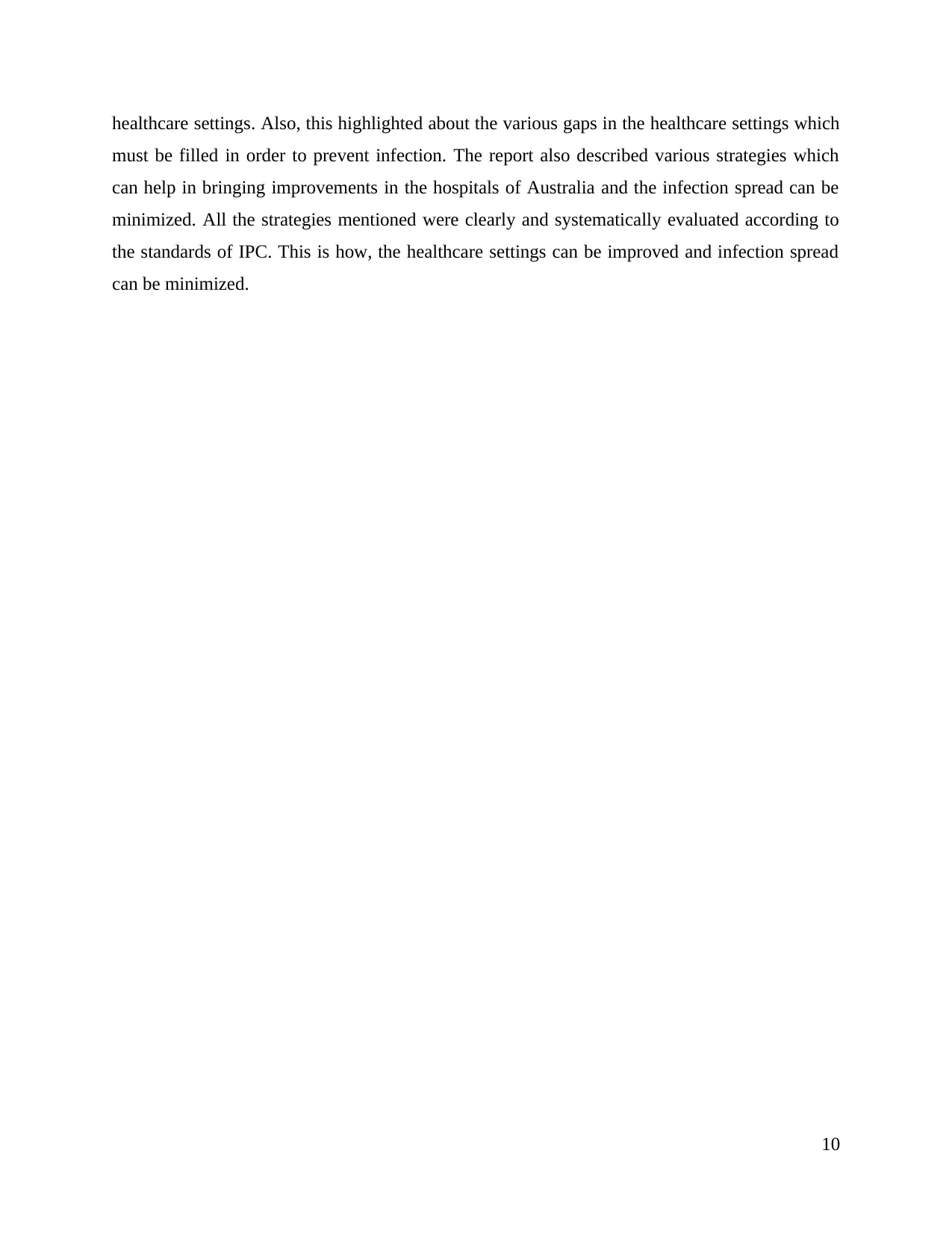
healthcare settings. Also, this highlighted about the various gaps in the healthcare settings which
must be filled in order to prevent infection. The report also described various strategies which
can help in bringing improvements in the hospitals of Australia and the infection spread can be
minimized. All the strategies mentioned were clearly and systematically evaluated according to
the standards of IPC. This is how, the healthcare settings can be improved and infection spread
can be minimized.
10
must be filled in order to prevent infection. The report also described various strategies which
can help in bringing improvements in the hospitals of Australia and the infection spread can be
minimized. All the strategies mentioned were clearly and systematically evaluated according to
the standards of IPC. This is how, the healthcare settings can be improved and infection spread
can be minimized.
10
Paraphrase This Document
Need a fresh take? Get an instant paraphrase of this document with our AI Paraphraser
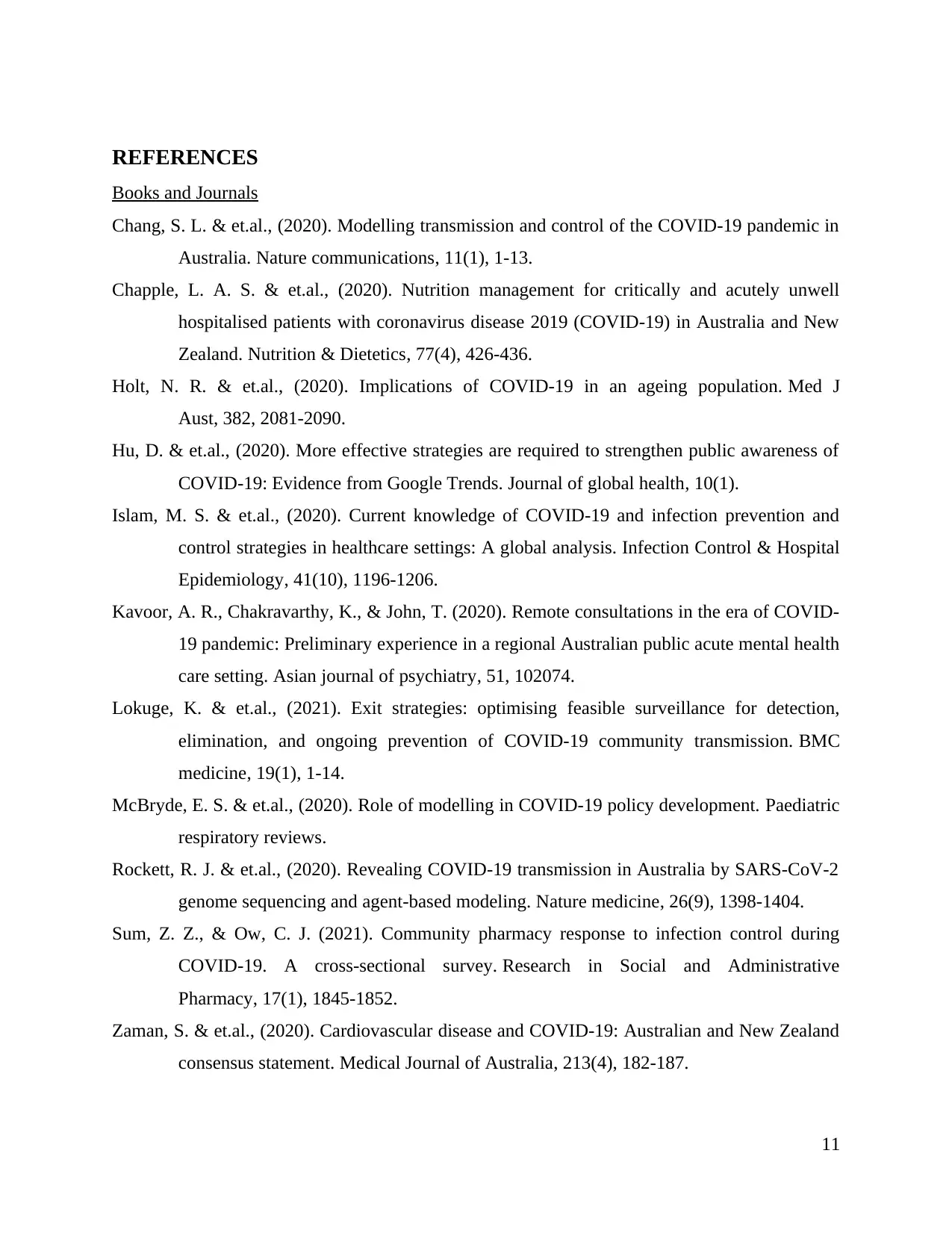
REFERENCES
Books and Journals
Chang, S. L. & et.al., (2020). Modelling transmission and control of the COVID-19 pandemic in
Australia. Nature communications, 11(1), 1-13.
Chapple, L. A. S. & et.al., (2020). Nutrition management for critically and acutely unwell
hospitalised patients with coronavirus disease 2019 (COVID‐19) in Australia and New
Zealand. Nutrition & Dietetics, 77(4), 426-436.
Holt, N. R. & et.al., (2020). Implications of COVID-19 in an ageing population. Med J
Aust, 382, 2081-2090.
Hu, D. & et.al., (2020). More effective strategies are required to strengthen public awareness of
COVID-19: Evidence from Google Trends. Journal of global health, 10(1).
Islam, M. S. & et.al., (2020). Current knowledge of COVID-19 and infection prevention and
control strategies in healthcare settings: A global analysis. Infection Control & Hospital
Epidemiology, 41(10), 1196-1206.
Kavoor, A. R., Chakravarthy, K., & John, T. (2020). Remote consultations in the era of COVID-
19 pandemic: Preliminary experience in a regional Australian public acute mental health
care setting. Asian journal of psychiatry, 51, 102074.
Lokuge, K. & et.al., (2021). Exit strategies: optimising feasible surveillance for detection,
elimination, and ongoing prevention of COVID-19 community transmission. BMC
medicine, 19(1), 1-14.
McBryde, E. S. & et.al., (2020). Role of modelling in COVID-19 policy development. Paediatric
respiratory reviews.
Rockett, R. J. & et.al., (2020). Revealing COVID-19 transmission in Australia by SARS-CoV-2
genome sequencing and agent-based modeling. Nature medicine, 26(9), 1398-1404.
Sum, Z. Z., & Ow, C. J. (2021). Community pharmacy response to infection control during
COVID-19. A cross-sectional survey. Research in Social and Administrative
Pharmacy, 17(1), 1845-1852.
Zaman, S. & et.al., (2020). Cardiovascular disease and COVID‐19: Australian and New Zealand
consensus statement. Medical Journal of Australia, 213(4), 182-187.
11
Books and Journals
Chang, S. L. & et.al., (2020). Modelling transmission and control of the COVID-19 pandemic in
Australia. Nature communications, 11(1), 1-13.
Chapple, L. A. S. & et.al., (2020). Nutrition management for critically and acutely unwell
hospitalised patients with coronavirus disease 2019 (COVID‐19) in Australia and New
Zealand. Nutrition & Dietetics, 77(4), 426-436.
Holt, N. R. & et.al., (2020). Implications of COVID-19 in an ageing population. Med J
Aust, 382, 2081-2090.
Hu, D. & et.al., (2020). More effective strategies are required to strengthen public awareness of
COVID-19: Evidence from Google Trends. Journal of global health, 10(1).
Islam, M. S. & et.al., (2020). Current knowledge of COVID-19 and infection prevention and
control strategies in healthcare settings: A global analysis. Infection Control & Hospital
Epidemiology, 41(10), 1196-1206.
Kavoor, A. R., Chakravarthy, K., & John, T. (2020). Remote consultations in the era of COVID-
19 pandemic: Preliminary experience in a regional Australian public acute mental health
care setting. Asian journal of psychiatry, 51, 102074.
Lokuge, K. & et.al., (2021). Exit strategies: optimising feasible surveillance for detection,
elimination, and ongoing prevention of COVID-19 community transmission. BMC
medicine, 19(1), 1-14.
McBryde, E. S. & et.al., (2020). Role of modelling in COVID-19 policy development. Paediatric
respiratory reviews.
Rockett, R. J. & et.al., (2020). Revealing COVID-19 transmission in Australia by SARS-CoV-2
genome sequencing and agent-based modeling. Nature medicine, 26(9), 1398-1404.
Sum, Z. Z., & Ow, C. J. (2021). Community pharmacy response to infection control during
COVID-19. A cross-sectional survey. Research in Social and Administrative
Pharmacy, 17(1), 1845-1852.
Zaman, S. & et.al., (2020). Cardiovascular disease and COVID‐19: Australian and New Zealand
consensus statement. Medical Journal of Australia, 213(4), 182-187.
11
1 out of 11
Related Documents
Your All-in-One AI-Powered Toolkit for Academic Success.
+13062052269
info@desklib.com
Available 24*7 on WhatsApp / Email
![[object Object]](/_next/static/media/star-bottom.7253800d.svg)
Unlock your academic potential
Copyright © 2020–2025 A2Z Services. All Rights Reserved. Developed and managed by ZUCOL.





